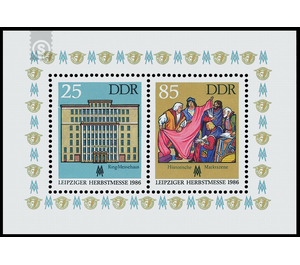Commemorative stamp series - Germany / German Democratic Republic 1986
Theme: Calender
| Country | Germany / German Democratic Republic |
| Issue Date | 1986 |
| Item Type | Block |
| Chronological Issue Number | 3187 |
| Chronological Chapter | GER-DDR |
| SID | 659251 |
| In 17 Wishlists | |
Leipzig Autumn Fair 1986 On the occasion of the Leipzig Autumn Fair 1986, the Ministry of Posts and Telecommunications of the German Democratic Republic issues a special postage stamp block with two multicolored special postage stamps. Special cancellation from 19 August to 18 October 1986 25-pfennig value: Ring-Messehaus For the Leipzig Autumn Fair 1926, the "Ring-Messehaus" opened its doors in full for the first time. Designed by the Leipzig architect Gutav Pflaume, this massive building with its very modest façade on the Ring of the Trade Fair City of Leipzig was an unprecedented size with its exhibition area of 13,000 square meters. In the 20s and 30s, furniture, sporting goods and advertising products were in addition to the product groups Many foreign exhibitors also found their trade fair headquarters. During the heavy bombing of Leipzig on the 4th of December 1943 during World War II, the "Ring-Messehaus" sank to rubble. But as early as December 1945, the Soviet city commander ordered the reconstruction of Leipzig's largest trade fair center, whose entire ground floor could then be used for the "First Leipzig Peace Fair" in May 1946. After the complete restoration to 1948 followed in the years 1954/55 still an extension building. The exhibition space increased to 18,000 square meters. Since the reconstruction, the textiles and clothing industry has found its home here, and the "Ring Fair House" was and is today considered the largest textile exhibition center in Europe. The "Ring-Messehaus" consists of the entrance building on the Tröndlinring and the north wing on the Humboldtstraße as well as the longhouse in between. If you want to see all the stands of the house, you have to walk at least 4.5 km. Time and again the visitors to the otherwise simple house are impressed by the dignified entrance hall. 85 Pfennig value: Historical market scene With a historical market scene about the cloth trade at the Leipziger Messe in earlier times, the Leipzig graphic artist and engraver Oswin Volkomer builds on similar representations by Erich Gruner. Erich Gruner (1881-1968) Leipzig graphic designer and creator of the world-famous trade fair symbol, the double MM, had also created many beautiful postage stamps for the Leipzig fairs. Even today, his depictions of the historic fair trade on the stamps of the years 1947 to 1950 are not only valued by philatelists. Oswin Volkamer chose the cloth trade for his design in order to establish a relationship with the "Ring-Messehaus", which is depicted on the other special postage stamp on the occasion of its 60th anniversary. The cloth trade is one of the oldest branches that are represented at the Leipzig Trade Fair. Already in the founding epoch of the goods fair cloth traders from near and far were present with their goods at the Pleiße. Also cloth from Flanders Lind England as well as silk from far away countries were handled in Leipzig, of course to a certain extent then processed here and finally offered for sale at the fair. In the 19th century, the so-called donkey market - where Brühl, Hainstraße and Große Fleischergasse meet - was the terrain of the cloth merchants. Not far away, the "Ring-Messehaus", today's exhibition building for textiles and clothing, was built in the 1920s. Incidentally, the name of the Gewandhaus Orchestra also bears witness to the significance that the textile trade and clothing trade already held in Leipzig in earlier times. Her house was the first venue of today's world-famous orchestra.


